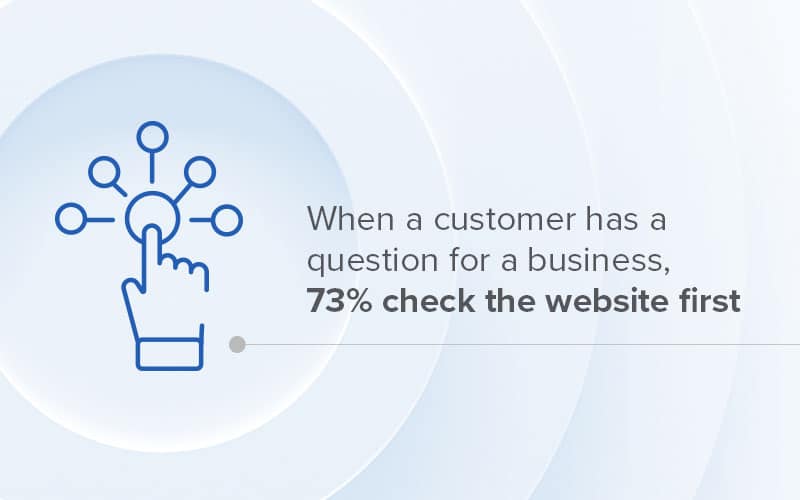Customers want answers to their questions in a convenient and timely manner. According to research, the most important attribute of customer service is fast response time. In order to get solutions quickly, customers prefer the self service options businesses now provide. Self-service tools can include websites, chatbots, SMS, and IVR.
When a customer has a question for a business, 73% check the website first. This is a clear signal that customers prefer to get answers themselves before reaching out to your business. There are opportunities for businesses to optimize their websites to make answers to frequently asked questions available and easy to find. If your website doesn’t do the trick, there are additional tools your business can implement to provide for customer service needs before it escalates to a call or support ticket.
Self-service options are critical for improving the customer experience, reducing the load on your agents, and lowering overall customer service costs. Once you’ve introduced these self-service channels into your customer journey, consider these metrics to determine if your channels are performing.
Case deflection
Case deflection is the rate at which your customers are able to find answers to their questions on their own without having to reach out to your support team via call or an agent-led chat. You can measure case deflection on your website, for example, by tracking the number of user visits that include a search and a click on results, but do not end in an escalation to a support ticket or additional outreach.
Another example of case deflection is when a user visits your support page, asks a question, is provided with suggested articles, and then leaves without filing a case. This is often a sign that the information you’re providing satisfies their needs.
Abandon rate
Take a look at your abandon rate – how often a customer visits your self-service pages and leaves quickly – when you want to understand how well your self-service tools are providing for the customer.
Content relevance
Content relevance is directly related to abandon rate. Is the content you’re providing your customers on the website or in the chatbot helpful? If it isn’t, you should expect your abandon rate to be higher. If the content is relevant, you should see customers clicking through provided information and being satisfied with the answers. Content relevance can also be measured by how many articles a customer needs to click through before finding the answers they need. You can also determine which content to surface first based on those clicks.
Recontact rate
If your customers are revisiting the same content or asking the same questions in your self-service tools, consider revamping your resources to better address customer needs.
Cost per contact
With the implementation of self-service tools, you may find that your cost per contact with a live agent actually increases, while your cost per contact including self-service interactions, goes down. When you are only routing escalated cases to live agents, the length of time needed to solve those issues likely increase. This means that the number of actual human interactions is going down and, therefore, the cost per call goes up. However, if you factor in the efficiency of self-service contacts, meaning you can serve more customers because you don’t need the help of live agents, your cost per contact across overall should decrease.
Call volume trend
Like cost per contact, call volume should decrease if your self-service options are performing. As call volume decreases, your support staff’s bandwidth increases in order to handle more pressing customer inquiries.
Customer satisfaction
Customer satisfaction should be one of your top self-service KPIs. The good news is that it is easier to deliver surveys to customers in self-service technology. Through your chatbot or post-call IVR surveys, you can gather feedback on your content, service, and technology to ensure your self-service options are providing the right quality of care.
Cost savings
In addition to measuring the cost per contact, measuring the overall cost savings to your contact center and support operations ultimately showcase the value of implementing self-service options. The highest cost to any contact center is the human talent. Self-service helps to automate interactions to reduce the need to hire agents to keep up with business growth. Additionally, self service allows the existing talent to focus on prioritized interactions.
Self-service options help your business thrive as you scale your contact center to support customers with high expectations for speedy and thorough service. Utilize the metrics above to optimize your channels and ensure your business is performing at its best and most efficiently.








